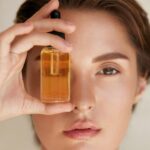A Summer skincare trend to try
By now, many of you have heard the popular skincare terms floating around the beauty industry. Depending on the trends, there can be so many new, hip buzz words and sometimes it’s hard to keep up! Here is an overview of one of those: microdosing, and how you can teach your clients to use this method in the sun, keeping them engaged and safe from skin damage. First of all, have you heard of it? If not, it’s definitely something that can be a great cheat code for your skincare routine and recommendations, especially for those with sensitive skin!
[ihc-hide-content ihc_mb_type=”show” ihc_mb_who=”2,4,6,7,5″ ihc_mb_template=”3″ ]
Microdosing became popular about two years ago and has taken skincare regimens from ‘zero to one hundred, real quick!’ It’s a major change, a frustration eliminator, and skin perfector! Yes, yes, I know you need to know how this works, right? First, let’s set the foundation of what it actually is. “Micro” means small and “dosing” means to assign a quantity. So when we are talking about this in skincare it means that you are taking a smaller dose of an ingredient and applying it or mixing it with a smaller dose of another.
Once you try it you’ll find it’s very effective no matter what skin type you have, even if it’s extremely sensitive. A lot of times when we’re trying to correct skin issues, we can over exfoliate or create irritation, so microdosing is most effective with products that exfoliate. Retinol, Lactic, Glycolic, and Salicylic acids are all ingredients that are great in this area, but also can cause damage to your skin’s barrier, which leads to dry skin, irritation, mask acne, and more. In the sunnier Summer months we need to make sure to educate our clients on which products to use less of and how to mix or layer under their SPF.
Let’s start with Retinol. It’s mostly used in a dosing of one to two percent in popular over the counter products, but because it is a powerful exfoliant, it can also be irritating. So a product with .1% – .25% retinol would be great to use to help cell turnover, increase skin firmness, and reduce hyperpigmentation and sebum, but not have the sensitivity of the higher dosage. A suggestion of more Vitamin C and less Retinol can be a combination that your client will appreciate!
Ingredients to microdose in conjunction with a topical exfoliant are peptides, niacinamides, and Vitamin C. Peptides are amino acids that are the building blocks of skin fibers like collagen and elastin, leading to firmer, more youthful skin. Niacinamides have been proven to reduce sensitivity, increase collagen production, and reduce uneven skin tone. Vitamin C helps reduce signs of UV damage, inhibits melanin production that leads to hyperpigmentation, and brightens your complexion. Imagine being able to get the great benefits of all 3 ingredients without worry or irritation. As I said before, it’s the ultimate cheat code!
Generally with oily skin, you can use a higher percentage of retinol and for sensitive and aging skin, I recommend a low dose (.1%-.5%), which is also appropriate for Summer. Remember, slow and steady wins the race. Before you know it, skin will appear plumper and brighter, and friends will think they’ve had work done, but you’ve just upped their skincare game, so they can sing your praises. Yaaaaassss!
Because YOU are the expert, you are responsible for creating an environment where your clients know they can come to you for sound advice and you also can provide them with what they need. Just as we change our skincare protocols, we need to change our clients’ home care protocols. Show them how to microdose and explain why they need a new regimen through the end of Summer.
Take some time to look through the products you sell. Do you have all of the key ingredients on your shelf? If not, order some asap! Then sit down and set a plan from June through September. Your plan should include:
• Creation of a Summertime facial menu.
• Sending out an announcement to your clients educating them on why it’s time to switch products for the Summer.
• Promotion of your seasonal protocols: “Take a look at our Summer 2023 Skincare Treatments!”
• Create your sales goals for products and services, for example, number of facials/products sold or a definitive dollar amount.
Are you ready to educate your clients and increase Summertime sales? I say go for it! Think big! Be sure to have that SPF in stock and on the shelf for every client to take home! This will not only help create loyalty, but it will also increase your referrals and sales from those that visit your practice. You are your local skincare expert and esthetician, and a licensed, reliable source. Giving great advice and education is a win-win for all of us in the industry!
[/ihc-hide-content]












